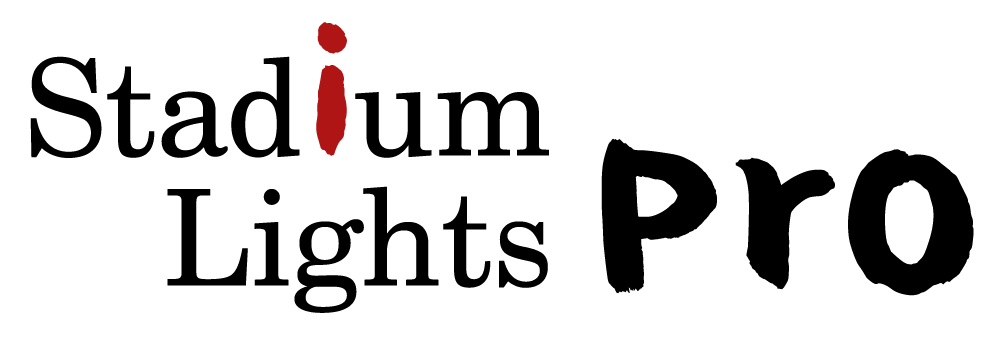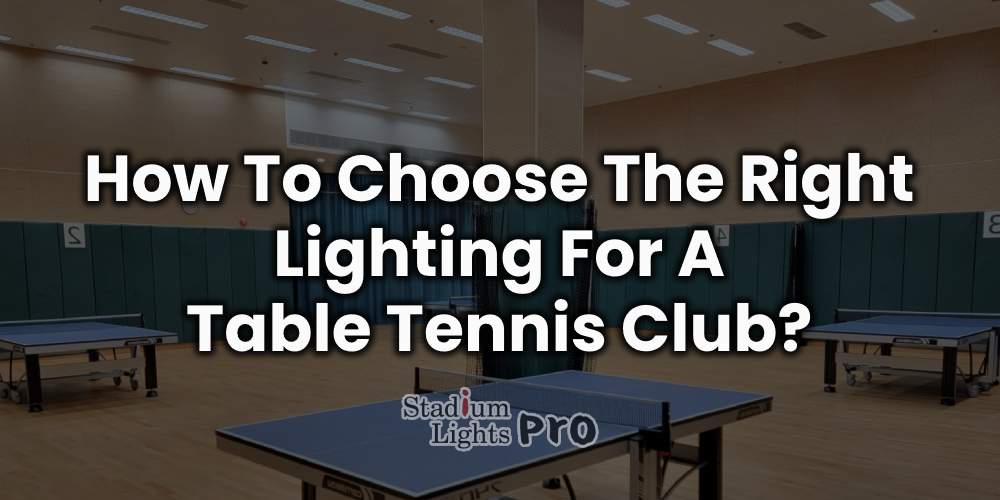A well-lit environment fosters better gameplay, allowing players to perform at their best and enjoy the sport more thoroughly. Poor lighting, on the other hand, can lead to inconsistent play, increased fatigue, and even accidents due to misjudgment of the ball’s movement.
Table of Contents
ToggleUnderstanding Lighting Requirements
Standards and Regulations
Choosing the right lighting for a table tennis club involves adhering to specific standards and regulations designed to ensure optimal visibility and safety. The International Table Tennis Federation (ITTF) provides detailed guidelines for lighting in table tennis facilities. According to ITTF standards, the lighting must deliver a uniform illumination of at least 500 lux on the playing surface for general use, with professional and competitive settings requiring up to 1000 lux or more. The light should be evenly distributed across the entire playing area to prevent shadows and inconsistencies that could affect players’ perception and reaction times. The color rendering index (CRI) should be high (preferably above 80) to ensure that colors appear natural and the ball is easily distinguishable against different backgrounds.
In addition to ITTF standards, local and national regulations must be considered. These regulations might include guidelines on energy efficiency, fixture safety, installation practices, and compliance with building codes. Adherence to these regulations not only ensures the safety and legality of the lighting setup but also helps in optimizing energy usage and reducing long-term costs. Therefore, it is essential to consult relevant local authorities and regulations during the planning and implementation of lighting systems for a table tennis club.
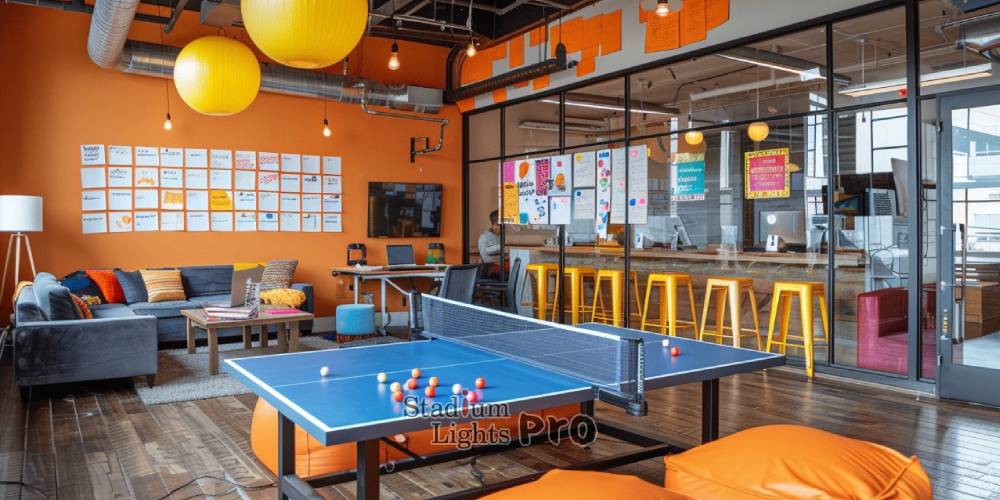
Types of Play
The type of play conducted in the table tennis club significantly influences the lighting requirements. For training and recreational use, the emphasis might be on providing adequate illumination that facilitates a comfortable playing experience without necessarily meeting the high lux levels required for professional matches. Lighting should still be uniform and free from glare to allow players to practice effectively and enjoy their sessions.
Conversely, professional matches and competitive play demand stricter adherence to lighting standards to ensure fairness and high performance. The lighting must be bright and consistent, with a higher lux level to accommodate the fast pace and precision required in professional games. Players in competitive settings rely heavily on the ability to see the ball’s spin and trajectory clearly, making high-quality lighting crucial.
Moreover, the lighting setup should be adaptable to cater to different recreational and competitive uses, allowing for adjustments in brightness and color temperature as needed. This flexibility ensures that the club can accommodate various types of activities, from casual games to official tournaments, while providing an optimal visual environment for each scenario.
Types of Lighting
Choosing the appropriate lighting type for a table tennis club is crucial for ensuring optimal visibility and player comfort. Different lighting technologies offer various benefits and drawbacks, which must be carefully evaluated based on the club’s specific needs and budget.
LED Lighting
LED lighting has become the preferred choice for many modern table tennis clubs due to its numerous advantages. LEDs are highly energy-efficient, consuming significantly less power than traditional lighting options, which can result in considerable cost savings on electricity bills. They also boast a long lifespan, often lasting tens of thousands of hours, which reduces the need for frequent replacements and maintenance. Additionally, LEDs offer excellent color rendering, with a high Color Rendering Index (CRI) that ensures colors appear natural and vibrant, making the ball easier to see and the playing environment more visually comfortable.
However, there are some considerations to keep in mind when selecting LED lighting. The initial cost of LED fixtures can be higher than other lighting types, though this is often offset by their long-term savings and durability. Quality variations among LED products can also be significant, so it’s important to choose reputable manufacturers and models to ensure consistent performance and reliability.
Fluorescent Lighting
Fluorescent lighting is a widely used option, particularly in facilities that prioritize cost-effectiveness. Fluorescent lights are generally cost-effective in terms of initial purchase price, making them a budget-friendly choice for many table tennis clubs. Their widespread use in various applications has made them a common and accessible option for general lighting needs.
Despite their advantages, fluorescent lights come with considerations that may impact their suitability for table tennis clubs. They can have flicker issues, which can be distracting and uncomfortable for players, particularly in high-speed sports like table tennis where visual clarity is crucial. Additionally, fluorescent lights are less energy-efficient compared to LEDs, and their lifespan is shorter, leading to more frequent replacements and potentially higher long-term costs.
Halogen Lighting
Halogen lighting is known for its high-intensity output, providing bright and clear illumination that can be beneficial for sports settings. Halogen lights also offer good color rendering, ensuring that colors are vivid and true to life, which is important for accurately seeing the ball and the playing environment.
However, halogen lights have notable considerations that may limit their practicality for table tennis clubs. They produce significant heat output, which can contribute to an uncomfortable and warm environment, particularly in enclosed spaces. This can lead to additional cooling costs and potential discomfort for players. Furthermore, halogen lights are known for their higher energy consumption, making them less energy-efficient and more expensive to operate over time compared to LEDs or fluorescents.
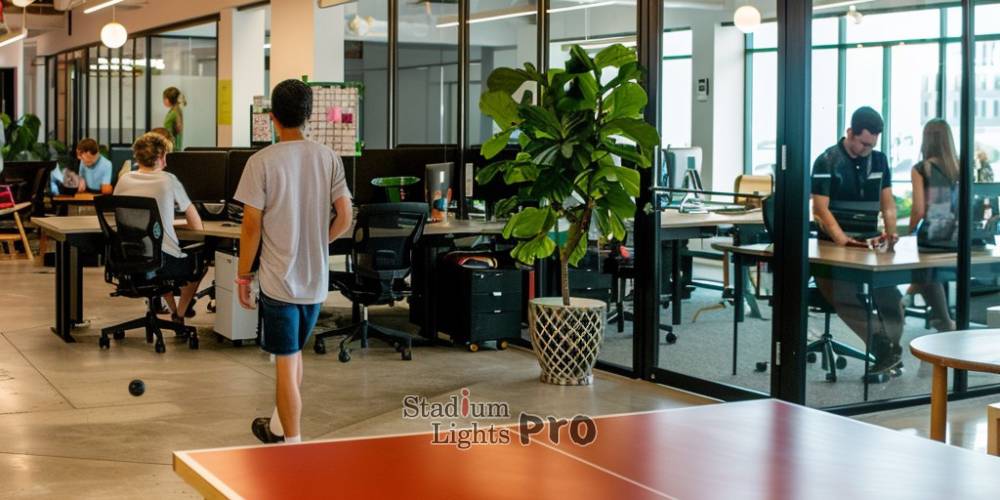
Lighting Design Principles
Designing an effective lighting system for a table tennis club requires careful consideration of several key principles to ensure a visually comfortable and high-performance environment. These principles encompass uniformity and coverage, color temperature, and lumen output, all of which contribute to an optimal playing experience.
Uniformity and Coverage
Achieving uniformity and coverage in lighting is essential for maintaining consistent visibility across the entire playing area. Even lighting distribution ensures that the playing surface is illuminated without significant variations in brightness, which can affect players’ ability to track the ball and anticipate its movement. Uniform lighting helps in avoiding shadows and glare, both of which can be distracting and hinder performance. Shadows can obscure the ball or other players, while glare can cause discomfort and reduce visibility. Proper fixture placement and design, including the use of diffusers or anti-glare coatings, can help minimize these issues, providing a clear and comfortable visual field for players.
Color Temperature
The color temperature of the lighting significantly impacts the overall ambiance and functionality of the table tennis club. A recommended range of 4000K to 6500K provides a balance between warm and cool light, enhancing visibility and reducing eye strain. Lighting within this range offers a neutral to slightly cool white light, which is conducive to high-focus activities like table tennis. Cooler temperatures (closer to 6500K) may be preferred in professional settings for their bright, daylight-like quality, which can improve concentration and reaction times. Warmer temperatures (closer to 4000K) might be more suitable for recreational play, providing a more relaxed and comfortable atmosphere. The chosen color temperature should enhance visibility and gameplay, ensuring that the ball and surroundings are easily distinguishable without causing visual fatigue.
Lumen Output
The lumen output of the lighting system is crucial for ensuring adequate brightness for playing table tennis. The required lumens per square meter (lux) can vary depending on the type of play, but general guidelines suggest around 500 lux for recreational use and up to 1000 lux or more for professional and competitive settings. This translates to a specific amount of lumen output needed to cover the playing area effectively, typically calculated based on the size of the space and the height of the fixtures. Balancing the brightness with comfort is key; the lighting should be bright enough to provide clear visibility and allow players to see the ball and surroundings easily, but not so intense that it causes glare or eye strain. Proper lumen output, combined with uniformity and the appropriate color temperature, creates an environment where players can perform at their best, whether during casual games or intense competitions.
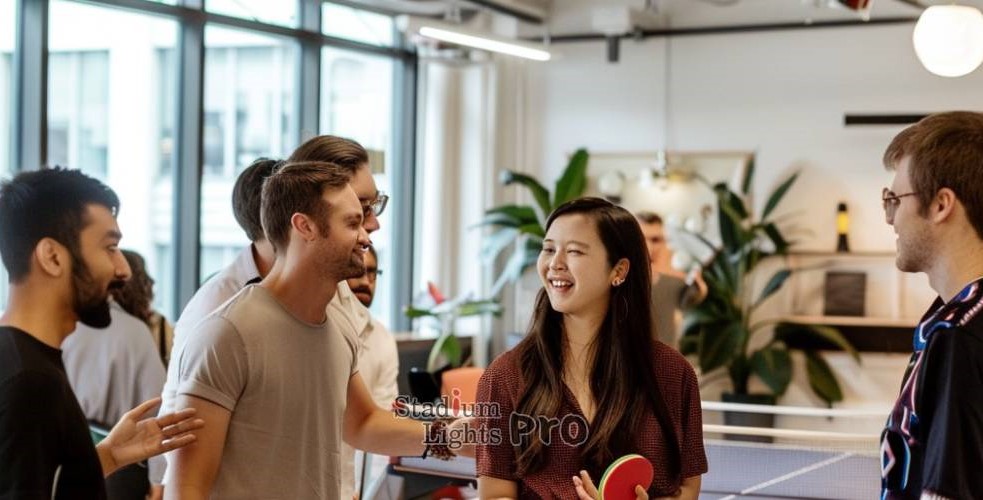
Fixture Placement and Installation
Proper placement and installation of lighting fixtures are crucial to achieving optimal illumination in a table tennis club. Key considerations include the height and positioning of fixtures, spacing and layout strategies, and electrical requirements to ensure effective and efficient lighting.
Height and Positioning
Height and positioning of lighting fixtures play a vital role in achieving even illumination and minimizing shadows and glare. The optimal mounting height for fixtures is typically around 4 to 5 meters (13 to 16 feet) above the playing surface. This height allows the light to spread evenly across the table and playing area, reducing the risk of shadows and providing adequate coverage. Fixtures should be positioned to cast light directly onto the playing surface rather than from oblique angles, which can create distracting shadows.
The ideal angles for fixture placement are also important. Fixtures should be angled such that the light beams intersect slightly above the playing surface, providing a uniform spread without direct light entering the players’ eyes. Adjusting the angle of the fixtures can help in minimizing glare, especially if using high-intensity lights like LEDs or halogens. Anti-glare shields or diffusers can be employed to further reduce any direct light exposure and enhance player comfort.
Spacing and Layout
The spacing and layout of the lighting fixtures determine how well the playing area is illuminated. Two common approaches are grid patterns and linear arrangements:
Grid Patterns
In a grid layout, fixtures are evenly spaced in a square or rectangular grid across the ceiling. This method provides uniform coverage and is particularly effective in larger or square-shaped rooms. Grid patterns ensure consistent illumination and are adaptable to various room sizes.
Linear Arrangements
Linear layouts involve placing fixtures in rows parallel to the playing area. This approach is often used in rectangular or elongated rooms. Linear arrangements can be beneficial in directing light specifically over the playing areas, but careful planning is required to avoid overlapping beams or creating dark spots between rows.
Coverage strategies vary depending on the room size and shape. Smaller rooms may require fewer fixtures placed closer together, while larger rooms might need more fixtures spaced further apart. The goal is to maintain consistent light levels across the entire playing surface, avoiding bright spots or dim areas that could affect gameplay.
Electrical Considerations
Electrical considerations are essential for the safe and effective installation of lighting fixtures. Proper wiring requirements must be followed to ensure that the fixtures are correctly powered and that the lighting system is reliable. This involves calculating the total electrical load, choosing appropriate wiring sizes, and ensuring that circuits are not overloaded.
The compatibility with existing infrastructure is also important. When upgrading or installing new lighting, it’s necessary to check whether the existing electrical system can support the new fixtures, both in terms of capacity and voltage requirements. In some cases, rewiring or the addition of new circuits may be necessary to accommodate the lighting system. Using energy-efficient fixtures like LEDs can help reduce the overall electrical load, making it easier to integrate with the existing infrastructure.
In summary, careful planning of fixture placement and installation is crucial to achieving effective lighting in a table tennis club. Considering the height and positioning of fixtures, choosing the right spacing and layout, and addressing electrical requirements ensures a well-lit, comfortable, and safe playing environment.
Customization and Flexibility
Customizing the lighting system in a table tennis club enhances versatility and allows for optimal adjustments to meet varying needs. This section explores the benefits of dimmable options, integration with lighting controls, and the advantages of color adjustability for creating different atmospheres.
Dimmable Options
Dimmable lighting provides flexibility in adjusting light levels according to different activities and preferences within the table tennis club. By dimming the lights, clubs can create a more subdued atmosphere for casual play or training sessions, reducing glare and creating a more comfortable environment for players. Dimmable options also allow for energy savings during times when maximum brightness is not required, contributing to overall operational efficiency. Integration with lighting controls enables precise adjustments, whether through manual controls or automated systems, providing convenient management of light levels throughout the facility.
Benefits of Adjustable Lighting Levels
Adjustable lighting levels cater to various requirements within a table tennis club, from recreational play to competitive matches and events. Higher light levels may be needed for tournaments or professional games to ensure optimal visibility and performance. Conversely, lower light levels can create a more relaxed ambiance for social events or gatherings. The ability to tailor lighting levels enhances player comfort and concentration during intense gameplay while accommodating diverse activities and preferences across different club functions.
Integration with Lighting Controls
Integrating the lighting system with advanced lighting controls enhances operational efficiency and user convenience. Automated controls can schedule lighting presets for different times of day or events, ensuring consistent and appropriate illumination levels without manual adjustment. This automation simplifies management tasks for club staff while maintaining optimal lighting conditions throughout the facility. Additionally, remote access and monitoring capabilities allow for real-time adjustments and troubleshooting, improving overall system reliability and performance.
Color Adjustability
RGB (Red, Green, Blue) and tunable white options offer enhanced flexibility in creating diverse atmospheres and visual effects within the table tennis club. RGB lighting allows for dynamic color changes and effects, ideal for themed events, competitions, or special occasions. Tunable white lighting enables adjustment of color temperature, from warm to cool hues, to suit different activities and user preferences. This adaptability enhances the overall ambiance of the club, contributing to a more engaging and enjoyable experience for players and spectators alike.
Creating Different Atmospheres for Events
The ability to adjust colors and lighting levels effectively transforms the table tennis club into a multifunctional space capable of hosting a variety of events. By customizing lighting settings, clubs can create distinct atmospheres that align with specific themes, seasons, or event requirements. Vibrant colors and dynamic lighting effects can enhance the excitement of tournaments or celebrations, while softer lighting tones promote relaxation and social interaction during casual gatherings or post-game activities. This versatility not only enhances the overall aesthetic appeal of the club but also enhances the overall experience for participants and visitors.
Health and Safety Considerations
Ensuring the health and safety of players and visitors in a table tennis club involves addressing various lighting-related factors, including minimizing glare, promoting eye comfort, and considering the importance of color rendering.
Minimizing Glare
Glare can be distracting and uncomfortable for players, affecting their performance and overall experience. Implementing anti-glare coatings and diffusers on lighting fixtures helps to scatter light evenly and reduce direct glare. These solutions disperse light rays and soften harsh shadows, creating a more uniform illumination across the playing area. Additionally, using fixture designs that direct light away from players’ eyes and towards the playing surface can significantly reduce glare and enhance visual comfort during gameplay.
Eye Comfort
Eye comfort is essential in maintaining player focus and preventing fatigue during extended playing sessions. Avoiding flicker and harsh lighting is crucial, as these factors can strain the eyes and lead to discomfort or headaches. Choosing lighting with a high Color Rendering Index (CRI), ideally above 80, ensures that colors appear natural and vibrant. This enhances visual clarity and allows players to distinguish the ball’s spin and trajectory accurately. High CRI lighting also reduces eye strain by providing a more comfortable and visually appealing environment.
Importance of High CRI (Color Rendering Index)
The Color Rendering Index (CRI) measures the ability of a light source to accurately render colors compared to natural light. In a table tennis club, a high CRI is essential for accurately perceiving the ball’s color and movement. Lighting with a high CRI enhances visibility and improves the overall playing experience by ensuring that players can see the ball and surrounding environment clearly. This is particularly important during competitive matches, where precise visual cues are crucial for making split-second decisions and achieving peak performance.
Conclusion
Choosing the right lighting for a table tennis club involves balancing key factors like adherence to standards, efficiency, and user comfort. LED lighting, despite higher initial costs, offers superior longevity and energy savings compared to traditional options. Prioritizing quality ensures optimal visibility and minimal maintenance over time. Integrating flexible lighting controls enhances adaptability for different activities, improving overall user experience. By making informed decisions that prioritize these factors, clubs can create a safe and enjoyable environment that meets both recreational and competitive needs effectively.
